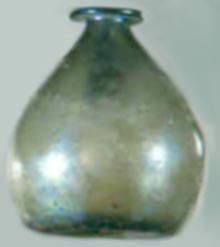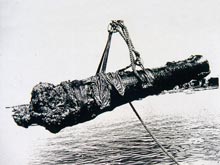With French boats sympathetic to the American colonists bearing down, the captain of the HMS Cerberus wrecked her to prevent her capture. This cannon, used in key battles in both the French and Indian War and the Revolutionary War, was recovered in the 1970s. Click image for larger view and image credit.
Personal items onboard the Cerberus, including this shoe, were effectively preserved for over 200 years under a protective layer of silt. Click image for larger view and image credit.

Some artifacts, like this glass bottle, have been recovered from the Cerberus, Lark, and Orpheus. During AUVfest 2008, archaeologists will use non-destructive sensors, mounted on autonomous underwater vehicles (AUVs), to survey what remains — scattered and buried — beneath the Narragansett Bay mud.
Rhode Island Archaeology
May 14, 2008
Charlotte Taylor
Maritime Archaeologist
Rhode Island Historical Preservation and Heritage Commission
Rhode Island, the "Ocean State," has more shipwrecks per square mile than any other state. We know of more than 2,000 ships that have sunk in its waters, and there are certainly many more. Some sank navigating the reefs off the state’s south shore, the passages through Narragansett Bay, and the treacherous coast of Block Island.
The majority of these ships — commercial vessels, passenger boats, and fishing boats — sank in the 19th century, victims of bad weather and navigational errors. Others were deliberately sunk during the Revolutionary War and afterward. In 1896, the Navy built the Goat Island torpedo station, and spectators flocked to the shores of Newport to watch the Navy blow up derelict vessels for target practice. (Rhode Island also claims U-853, the last German submarine sunk during World War II, which lies off Block Island. Her final victim, the coal carrier Black Point, lies off Point Judith.)
The Revolutionary War shipwrecks are perhaps the most significant underwater sites in Rhode Island. The British ordered a fleet of their transports sunk in Newport’s Outer Harbor to block the passage between the mainland and Goat Island. Among the transport ships sunk was the Lord Sandwich, which the famous British explorer Captain James Cook once sailed under the name Endeavour. To avoid capture by the powerful French fleet, the British wrecked four of its own frigates, running the Cerberus, the Lark, the Juno, and the Orpheus aground, felling the masts, and torching the vessels.
After the British left Rhode Island in 1779, the state's General Assembly claimed ownership of all the abandoned British property and sold the salvage rights to their hulks. Although the general area of the vessels’ demise — the western shore of Aquidneck Island — was known, none of the vessels had been precisely located. Along that shoreline, very little maritime activity occurred, except for the passage of commercial vessels. Onshore, the land north of Newport along the western Aquidneck Island shore was farmed until the mid 20th century. It also saw the erection of the Middletown railroad station, the Portsmouth coal mines (later, the Kaiser Aluminum plant), a Navy depot, and an oil tank fueling system. Today, a large industrial park and a private golf course and residential community exist on the land near the wreck sites. A shellfish farm is the only stationery maritime activity near the wreck sites.
Despite little disturbance, the remains of most wooden vessels over a hundred years old in Rhode Island waters consist of timbers buried under a protective layer of silt. If the silt is disturbed by archaeology or other activities, the exposed parts of the ship decay until they are reburied. Even metal vessels decay. Concrete vessels, such as those made in the early 20th century, survive well. For the most part, however, the state’s older wrecks are hard to find, decayed, or buried beneath the silt.
In 1972, a graduate student at the University of Rhode Island located the sites of three of the frigates: Orpheus, Cerberus, and Lark. Even though the ships’ stores of gunpowder had exploded with enough violence to set houses ashore on fire, the Narragansett Bay silt had preserved the rigging, armaments, scattered timbers, and the crews' personal items. During the next few years, the student brought up a wide array of artifacts from these sites, resulting in a fascinating collection that gives a glimpse of life aboard English warships during the Revolution.
In the 1990s, the Rhode Island Marine Archaeology Project, under the direction of Dr. D.K. Abbass, began a more archaeologically rigorous study of the frigates and the transport fleet. It is work that continues today, with funding from NOAA.
The Lark and the Cerberus are two of the sites that will be examined during AUVfest 2008. Despite their discoveries over 30 years ago, the full extent of these sites is unknown, since the remains of the ships are scattered over a large area and covered by silt. AUVfest will also study two more recent shipwreck sites off Prudence Island, about which little is known. It is also possible that during AUVfest we will find the remains of previously unknown shipwrecks, buried beneath the mud of Narragansett Bay. We do know that the discoveries made during AUVfest 2008 will not disturb the sites themselves.

















